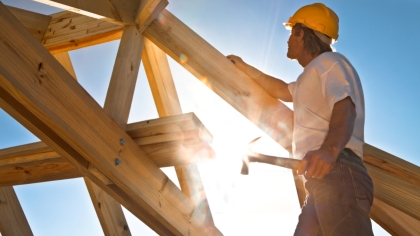
New Home Construction
Construction and take out financing of ground up residential, owner occupied properties, up to four units.
Read more
Use it to build a new home, remodel an existing one, or buy and build on a lot —and keep it long term.
Two options are available; a stand-alone Home Construction Loan or a Construction to Permanent Loan.
The latter is a simple financing solution because it gets you from purchase or refinance to the construction phase and interest reserve to long-term financing with just one loan.
You qualify for the loan up front, lock in your permanent interest rate, sign a single set of loan documents, get up to a year (or longer) to complete your construction project, and you don’t have to revisit the financing or appraisal when you’re done.
First, we’ll cover the stand-alone variety.
The above traditional approach to residential construction loans was the only option available until the advent of the Construction to Permanent Loans.
A construction to permanent loan works for building or remodeling a primary residence or second home, purchasing raw developed or undeveloped land to build a new home, or buying and partially or completely demolishing and rebuilding an existing house.
If you already own the home you want to demolish, or the land you want to build on the loan will pay off your existing mortgages as well as covering the soft and hard costs of construction, interest reserves and contingency reserves of the new home.
At closing, the first disbursement covers the old mortgages or down payment and closing costs.
The rest of the funds are disbursed at predetermined intervals and amounts based on the construction budget and timeline from your contractor.
At the end of each stage of construction, the lender inspects the progress, the title company updates the title report to check for liens, and then the disbursement check is issued.
Importantly, each disbursement is a reimbursement for funds already spent, meaning that the contractor or you have to have enough resources to float the costs during each disbursement period.
You, as the homeowner, must have a clear understanding with your contractor of who is paying for what or else you are likely to end up with misunderstandings and delays, which turn into cost overruns.
Lenders hold the final 10% of the funds until the final inspections are complete and an occupancy permit has been issued.
You will need to continue living in your existing property until your new home is ready to be occupied, and most people don’t qualify for two consecutive housing expenses.
Construction to Permanent financing solves that problem by setting up an interest reserve account that is included in the loan. During the course of construction, interest-only payments are calculated based on the amount actually drawn and charged against the interest reserve, reliving you of monthly payments for the new home during construction.
Depending on real estate market conditions, your current home can be listed for sale and timed to close as the new home is ready to occupy.
The appraiser uses the proposed home’s architectural plans in conjunction with the Cost of Construction Breakdown and the Materials List to find similar comparable sales in the area to determine the Future Value of the home to be built.
Some types of construction, such as Manufactured and Log Homes, present a challenge in that similar houses should be present in the area and at least one recent closed sale must be available to be included in the comparable sales.
Modular and Panelized Homes can readily be appraised using any similar size and quality of homes sold recently in the area without any restrictions.
A construction loan is a reimbursement loan, in that no funds are advanced to the borrower but rather reimbursed as each stage of construction is completed and signed off by the building inspectors and the lender’s inspector, and the title is updated by the title company. These staged reimbursements are called draws.
In a typical scenario, there are around 5 to 7 draws. There cannot be too many scheduled draws since the process is time consuming and associated with inspections and fees.
Sub-contractors, material suppliers, and the general contractor’s employees need to get paid well before a stage of construction is completed, and that is either the responsibility of the contractor or the homeowner. There should therefore be a clear understanding with the general contractor, clearly covered in the contract, as to who pays for what and when.
In the case of Panelized, Modular, or Log Construction, lenders do advance funds for deposits, so long as arrangements are made during the approval process, as these suppliers will not even start work on the components, let alone deliver without a substantial deposit.
There are some risks during the course of construction which lenders require protections for that are not normally included in a homeowner’s policy. These include:
It is important to have a clear understanding with the general contractor as to who pays for what, and to have it in writing in the contract.
In addition to the standard credit and income qualifications, new home construction loans require determination of value of your new home—before it exists. They do by understanding everything that will be involved in that process.
Because all of these calculations go into the loan approval, you have to have architectural plans and a cost breakdown before you can apply for your loan.
They’ll also need your contractor’s license, resume, references, proof of insurance, and your signed contract. After all – their money is on the line, so if your contractor has a poor record, they won’t be anxious to approve the loan.
Note that they are inspecting the contractor’s financial history, not their workmanship; that’s up to you, so choose carefully.
Basic documentation requirements are explained in more detail in the Documentation Requirements page.
You can usually finance the lesser of 85% of the cost of construction OR the Loan to Future Values as shown below.
But first, let’s define Cost of Construction. It includes:
| Documented Income | Stated Income | No Income Docs |
|---|---|---|
| 90% to $ 400,000 | 80% to $ 400,000 | 65% to $ 400,000 |
| 80% to $ 650,000 | 75% to $ 650,000 | 60% to $ 650,000 |
| 70% to $3,000,000 | 65% to $3,000,000 | 50% to $1,000,000 |
The following is a typical calculation; your lender may have a slightly different approach based on their guidelines.
| Example of a Construction Loan Amount Calculation | ||
|---|---|---|
| Land Purchase Price | $100,000 | or value if owned over a year |
| Soft Cost of Construction | $ 25,000 | plans, permits, etc. |
| Hard Cost of Construction | $225,000 | cost to build |
| Closing Costs | $ 13,750 | fees, title, escrow, etc. |
| Contingency Reserve | $ 11,250 | 5% of hard costs |
| Interest Reserve | $ 10,000 | to pay interest payments |
| Total Project Cost | $385,000 | |
| Future Value | $500,000 | based on appraisal |
Based on the numbers shown above, here’s how a loan amount for a full documentation loan would be calculated:
Step 1: 85% of project cost => 385,000 x 85% = $327,250
Step 2: Percentage (from table) of final value => $500,000 x 80% = $400,000
Step 3: $327,250 is the Lesser of steps 1 and 2, so that’s what you can finance
Step 4: $385,000 - $327,250 = $57,750 Minimum Down PaymentYou can plug in your own numbers in our construction loan budget calculator to figure out your loan amount.
A construction loan appraisal is commonly known as a Future Value Appraisal. The appraiser uses current sales comparisons based on the architectural plans and specifications based on the line item cost breakdown work sheet that the architect and/or the contractor supplies.

Construction and take out financing of ground up residential, owner occupied properties, up to four units.
Read more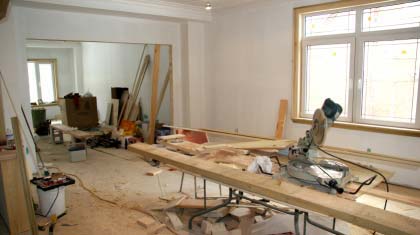
Major remodeling loans for currently owned or purchase and rehabilitation of residential properties, up to four units.
Read more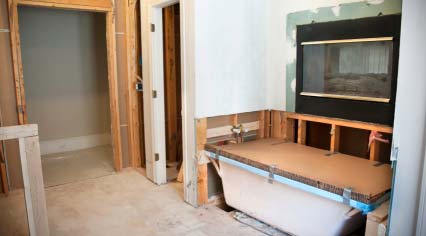
FHA's rehabilitation loan program for currently owned homes and purchase transactions of up to four units.
Read more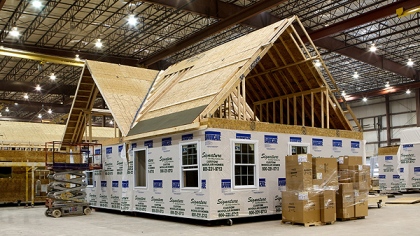
Modular, manufactured & fifth wheel homes. What are the differences? Is financing be available for them?
Read more
Construction loans are available for damaged credit, but things can work very differently in this case.
Read more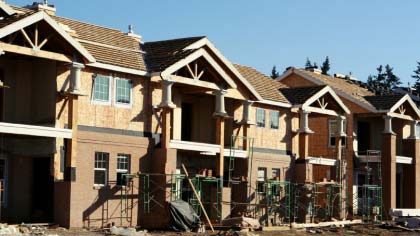
Also known as spec loans these are for speculators who plan on building several homes or a condo project.
Read more
Lot Loans for when you are not ready to build, but the opportunity presents itself. For up to Four Units.
Read more
For hard to document income or very complex combination of corporate and/or trust and personal returns.
Read more
Typical closing costs for a construction loan are a little different from conventional mortgages.
Read more